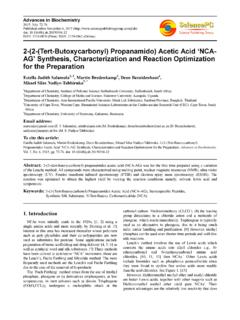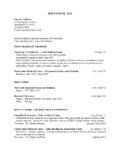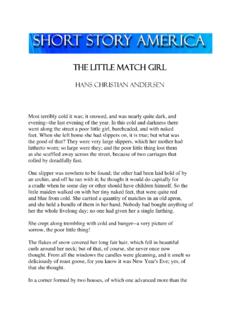Transcription of The Buttonmonger
1 The controversy over the quan-tity of gold and the quality of the gilding led manufacturers to stamp the backs of their buttons with claims and identi-fication marks. Typical quality marks are "Extra Rich," "Rich Gold Color (or "Colour"), "Treble Gilt," "Best Orange Gilt," or any combina-tion of those words ("Extra Or-ange Gilt," for example). The first gilt buttons were made in Birmingham between 1797 and 1800. Being ele-gant, yet affordable, people took to them immediately. Americans began making gilt buttons by 1810, after stealing the gilding secret from the British: Five grains of gold per gross (144) of buttons was added to a mixture of mercury, and then brushed on the brass buttons, which were then cooked in a furnace. Using this method, buttons could be gilt, double gilt or triple gilt The process of gilding buttons was so perfectly known in the 18th century that button mak-ers in England had to ask Par-liament for laws to keep the unscrupulous from gilding buttons with too little gold.
2 The approved amount was 1/96th of an ounce of gold to cover a 1 button. Some marks were informative. Double Gilt showed that twice the legal amount of gold was applied. Treble Gilt meant that three times the legal limit of gold was applied. Other mark-ings such as Rich , Orange & Extra Fine were marketing attempts by the manufacturer to promote the quality of their buttons. g i l d e d B u t t o n s ! Buttons, a farthing a pair. Come, who will buy them of me? They re round and sound and pretty, And fit for girls of the city. Come, who will buy them of me? Buttons, a farthing a pair. Mother Goose G i l t B u t t o n s ( C o n t . ) THE LIFE, ART & HISTORY OF THE BUTTON The Buttonmonger July 2011 Volume 1, Issue 7 July Coupon Use the following code to receive 15% off any order placed in July 2011 A71I8H0JR2635 Extra Fine Gilt Treble Gilt Extra Rich Treble Gilt Superior Strong Plated Imperial Orange Gilt with a high proportion of tin.
3 This made them harder than many pewter buttons of the previous century. Their markers called them Hard Whites in an attempt to overcome the associa-tion with the cheap, low grade pewter button used by the working class. Between 1800 and 1830, the Ameri-can button industry was struggling to survive and improve its manufacturing processes. By the 1830s, American manufacturing had improved both the quality and manufacturing of massed produced gilt buttons. Thus, causing the demand for Hard Whites to drop off. Hard whites were made to resemble steel buttons popular at the time. Pewter is the generic name for a group of tin alloys whose compositions can vary quite considerably. The most common mix used in the 18th century was four or five parts tin to one part lead. The highest grades of pewter used about 90 percent tin to 10 per-cent copper, Early 19th century pewter buttons were made of a good grade of pewter Some makers went so far as to backmark their buttons "imitation steel.
4 Hard white pewters have steel or brass wire loop shanks embedded in a hump of metal on the back. Face patterns are usually conventional, with varia-tions of stars and pinwheels being the most popular. I am just a person living in a small in a small a lot of grand ideas. An artist, a poet, an eclectic collector of stuff and nonsense .. a quiet soul with flecks of cynicism and a sense of curiosity about the world around me. One wonder being the un-believable detail of an antique button. These little works of art were beautiful as well as served a purpose. Worn as jewelry way back when, nowadays when popped is not even worthy to some to lean over and be rescued. H a r d W h i t e B u t t o n s WE RE ON THE WEB! It is my goal to provide that best possible experi-ence to all visitors to my site.
5 If you have a question, comment or a concern, please contact me via email: or you can write to me at: The Buttonmonger Box 216 Chagrin Falls, Ohio 44022





